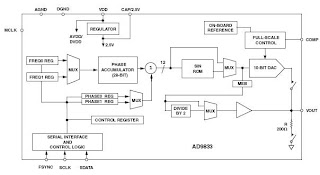MAX038
High-Frequency Waveform Generator
The MAX038 is a high-frequency, precision function
generator producing accurate, high-frequency triangle,
sawtooth, sine, square, and pulse waveforms with a
minimum of external components. The output frequency
can be controlled over a frequency range of 0.1Hz to
20MHz by an internal 2.5V bandgap voltage
reference and an external resistor and capacitor. The
duty cycle can be varied over a wide range by applying
a ±2.3V control signal, facilitating pulse-width modulation
and the generation of sawtooth waveforms.
Frequency modulation and frequency sweeping are
achieved in the same way. The duty cycle and frequency
controls are independent.
Feature♦ 0.1Hz to 20MHz Operating Frequency Range
♦ Triangle, Sawtooth, Sine, Square, and Pulse
Waveforms
♦ Independent Frequency and Duty-Cycle
Adjustments
♦ 350 to 1 Frequency Sweep Range
♦ 15% to 85% Variable Duty Cycle
♦ Low-Impedance Output Buffer: 0.1
♦ Low 200ppm/°C Temperature
datasheet
AD9833
Low Power 20 mW 2.3 V to 5.5 V
Programmable Waveform Generator

GENERAL DESCRIPTION
The AD9833 is a low power programmable waveform generator
capable of producing sine, triangular, and square wave outputs.
Waveform generation is required in various types of sensing,
actuation, and time domain reflectometry applications. The output
frequency and phase are software programmable, allowing easy
tuning. No external components are needed. The frequency registers
are 28 bits; with a 25 MHz clock rate, resolution of 0.1 Hz
can be achieved. Similarly, with a 1 MHz clock rate, the AD9833
can be tuned to 0.004 Hz resolution.
The AD9833 is written to via a 3-wire serial interface. This serial
interface operates at clock rates up to 40 MHz and is compatible
with DSP and microcontroller standards. The device operates
with a power supply from 2.3 V to 5.5 V.
The AD9833 has a power-down function (SLEEP). This allows
sections of the device that are not being used to be powered down,
thus minimizing the current consumption of the part, e.g., the DAC
can be powered down when a clock output is being generated.
The AD9833 is available in a 10-lead MSOP package.
FEATURESDigitally Programmable Frequency and Phase
20 mW Power Consumption at 3 V
0 MHz to 12.5 MHz Output Frequency Range
28-Bit Resolution (0.1 Hz @ 25 MHz Ref Clock)
Sinusoidal/Triangular/Square Wave Outputs
2.3 V to 5.5 V Power Supply
No External Components Required
3-Wire SPI® Interface
Extended Temperature Range: –40_C to +105_C
Power-Down Option
10-Lead MSOP Package
datasheet
CG-402R2

Sine wave output
Frequency can be set with two external resistors
Low distortion
Frequency ranges 20Hz to 1MHz
Technical specification
Output waveform Sine wave
Output voltage 2.5Vrms (variable)
Frequency setting method External resistor x2
Power supply voltage ±15V ±10%
Temperature humidity range Operation: -20 to 70°C, 10 to 95% RH
Storage -30 to +80°C, 10 to 80% RH
Technical data
Type Frequency Frequency stability External
CG-102R1 20Hz to 20kHz ±15ppm/°C 24-pin DIP
CG-402R1 20Hz to 20kHz ±50ppm/°C 12-pin SIP
CG-402R2 1kHz to 100kHz ±50ppm/°C 12-pin SIP
datasheet
